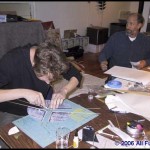Three years ago the Drachen Foundation completed an ambitious, multi-year project designed to draw the attention of European and American kite makers to an overlooked medium—paper. Used throughout Asia, paper is both functional and beautiful as a material for sails. The project, Paper Wings, included outreach to design schools, sart departments, and papermaking circles, as well as lectures by kite artists adept with paper and a worldwide paper kite competition.
The project’s culminating event, staged at the Panama Hotel Tea and Coffee House in Seattle, was a week-long invitational residency for eight established contemporary kite artists. DF chose artists with varying degrees of experience using paper as the primary kite sail material, from Robert Trépanier’s “almost zero” to Nobuhiko Yoshizumi’s more than thirty years. Kirsten (Kisa) Sauer had used paper-like ripstop for many years, Frank Schwiemann had used paper extensively in installation models, Anna Rubin had used natural materials exclusively in her kite making, and Scott Skinner had experimented with paper patchwork for almost five years. It was hoped that the kite makers could spend the entire week producing paper kites that would reflect their experience and vision, as well as the properties of paper that continue to make it a viable choice for contemporary kite makers.
Artists chose different approaches: some started with an “empty canvas,” while others prepared materials beforehand in order to produce in their own style. They decided against a defined theme; they were also confined to the limited table and studio space provided at the Panama Hotel. Finished kites demonstrated collage, paper patchwork, simple piece-work, painting and dyeing, and photocopying as decorative techniques. (Noticeably absent at this gathering was an artist who incorporated photography into the kite sail.) The kites very much reflected the established styles and approaches of each of the invited artists; there was limited artist-to-artist influence. From DF’s point of view, this was an acceptable and exciting result since the kites made showed the breadth of the spectrum of paper kites and how accessible, inexpensive, and non-threatening paper can be when compared to many high-tech contemporary kite making materials.
Among the most interesting documentation of the residency is the set of interviews with each artist conducted by Programming Assistant, Courtney de Rouen (shown here with Anna Rubin), whom DF was lucky to have on staff at the time. Fluent in German as well as English, she was able to interview the five German-speaking artists in their native language and then translate each interview. The interviews have just been added to DF’s digital archive and are also available on its website (link can be found at the end of this article).
Courtney asked each artist the following questions: when she or he first became interested in kites; what relation, if any, kites bore to her/his work; what experience s/he had with paper as a medium; what s/he was working on for the week; what kind of opportunity this residency offered. Answers to the first question ranged from the predictable childhood exposure (“that’s just what kids do”) to the search for a thesis topic (a quest with which graduate students worldwide can sympathize!) to work in a kite shop to slow-growing dedication over a decade of casual exploration. Although each artist worked in different ways, and usually produced different types and sizes of kites (affected by how big the space on a table, or the size of a sports car), most artists, whatever their level of familiarity with paper, acknowledged that it offered an appealing freedom to experiment. Christine Schwarting made “trash kites” from the paper Scott Skinner discarded; Kisa Sauer was similarly liberated from the “perfectionism” demanded by spinnaker, because of its expense. Robert Trépanier also pointed out “the speed with which you can do things [with paper]. In an hour, two hours, you can do something interesting because it’s really fast. Also, everybody knows how to work with paper, white glue, sticks, knots and line. It’s nothing technical, nothing complex.”
That freedom and expansiveness also characterized the atmosphere of the residency as a whole: in Anke Sauer’s turn of phrase, “It [was] almost as if the room [was] crackling.” Scott Skinner, president of the Drachen Foundation as well as one of the participating artists, felt that the paper kite residency would demonstrate that “you don’t have to be a technician to get results. You don’t have to be a great knot tier or bamboo splitter. You can use very simple sticks and just support here and there and make things work. You don’t have to be a great painter; you have other avenues. If you are a painter, you might find a way to use your work or put your work into a kite form or into a free-form object that flies.”
The interviews contain many details, from that moment in kite history, about the working process of each kite artist and his/her opinions about the attractions of kite building and flying. Anna Rubin spoke of the imagery she was using in the two series of kites she was creating at the time—and Yoshizumi-san commented on her technique in gluing together the coins for her “dollar plant” kite (look as well for his comments about Japanese “younger people”). Anke Sauer explained the evolution of her paper “pyramid” kites, her sister Kisa the twisty perspective of the “Skywalker” kites she developed while in Seattle. Christine Schwarting recounted a conversation with Peter Lynn and Robert Trépanier about the pleasures of kite flying. Frank Schwiemann thanked the “Düsseldorf Kite Friends” who tolerated the “little squirt” he once was at kite festivals. And Robert Trépanier (a mentor to several artists at different points in their careers) and Scott Skinner each discussed the impetus for the residency itself and the hopes that it might inspire more opportunities for paper kite creation and gallery display.
Links to the interviews:
[twocol_one]Anna RubinChristine Schwarting[/twocol_one] [twocol_one_last]Frank Schwiemann
Nobuhiko Yoshizumi[/twocol_one_last]
















